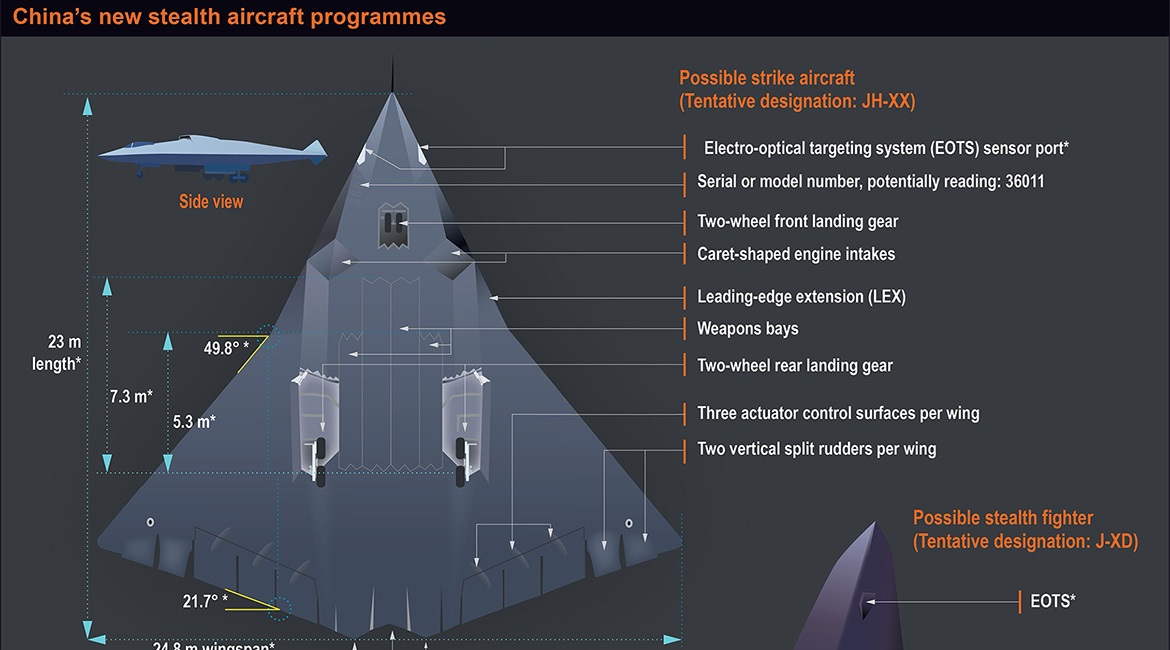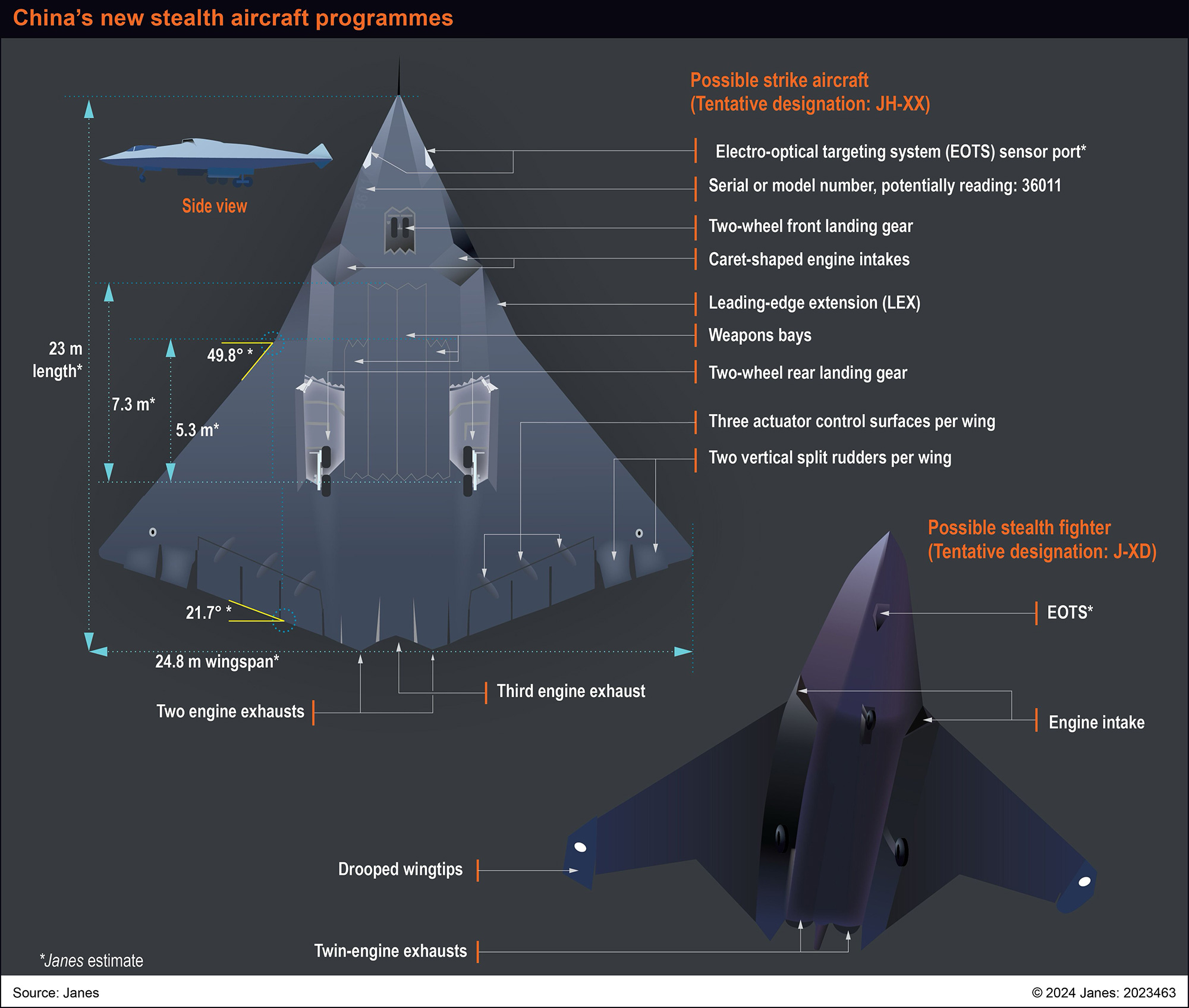
Date Posted: 30-Dec-2024
Author: Akhil Kadidal, Bangalore
Key points
- Chinese companies revealed flying prototypes of a possible new stealth bomber and stealth fighter
- Flight tests not only showcase Chinese advances in new stealth technologies but reveal Beijing's intent to acquire an edge over Western fifth- and sixth-generation programmes
China has revealed for the first time the existence of two new stealth aircraft currently under development, video imagery of which appeared on domestic social media channels on 26 December. Both aircraft have tailless configurations in addition to other novel design features.
The first aircraft to emerge online appeared to be a high-performance strike aircraft. The aircraft, which has an estimated length of 23 m and an estimated wingspan of 24.8 m, potentially appears to be powered by three engines.
With compound diamond-delta wings and leading-edge extensions (LEXs) nearly up to the nose, the aircraft's design is partially reminiscent of the J-20 family of aircraft. However, the aircraft's rearward design differs from that of the J-20.
The new aircraft's two primary engine intakes are caret-shaped and lack the diverterless supersonic inlet (DSI) bumps present on the J-20 family. A third engine intake is located in a dorsal position, behind what appears to be a cockpit. The resolution of images and videos of the aircraft do not yet confirm if the aircraft is a manned or unmanned platform.
The aircraft is also larger than the J-20, which has an estimated length of 20.9 m and a wingspan of 12.88 m.

China's two new stealth aircraft programmes include a possible long-range strike aircraft and a possible next-generation fighter. (Janes)
Two windows, likely for an electro-optical targeting system (EOTS), can be seen on both sides of the nose of the new aircraft. The aircraft conducted the flight trial in the wheels-down configuration. The video of the flight test shows that it was accompanied by a two-seat Chengdu Aircraft Industrial (Group) Company (CAC) J-20S fifth-generation aircraft in factory primer yellow, operating as a chase aircraft and equipped with camera pods.
The platform's designation is not known. Chinese military observers have tentatively connected the new aircraft to China's longstanding JH-XX stealth bomber programme. A number, 36011, was painted on the nose, behind the EOTS windows. CAC serial nomenclature is known to include aircraft designations. The J-20S that was acting as a chase aircraft, for example, had the number 2035. This suggests the JH-XX's designation includes ‘36'.
The aircraft had one primary internal weapons bay and two secondary bays with estimated lengths of 7.3 and 5.3 m respectively. These dimensions suggest that the bay is not only capable of accommodating China's newest very-long-range air-to-air missile (VLRAAM), the PL-17, which has an estimated length of 5.7 m, but also potential air-to-surface cruise missiles.
The tailless design is augmented with two split rudders per wing, with the aircraft also equipped with three control actuators per wing. The main landing gear has two-wheeled bogies, which may indicate a take-off weight in excess of 40 tonnes.
While the aircraft's manufacturing origins are unclear, it is possible that this is a CAC product. This is due to the fact that the aircraft was accompanied by a factory-fresh J-20S (a type which is not known to have entered service). The aircraft also appeared to have been filmed while operating over Chengdu city.
A video of the flight partially shows the main building of the Chinese Intangible Cultural Center in the northwestern part of the city, which is about 2 km (1.2 miles) east of the CAC factory and airfield.
Possible fighter
Hours after the imagery of the JH-XX aircraft appeared online, a video of a second in-flight tailless stealth aircraft was uploaded to Chinese social media. The imagery also showed a Shenyang J-16 multirole fighter aircraft acting as a chase aircraft.
Information on Chinese social media suggests that the flight test was conducted on 22 December over Shenyang city. The Shenyang Aircraft Corporation (SAC) factory and airfield (also known as factory 112) are located north of the city.
While clear images of this aircraft (tentatively designated as J-XD) are unavailable, it appears to be a twin-engine design with swept wings and two DSI bump-accompanying engine intakes. The aircraft also had drooped wingtips. An EOTS is installed underneath the nose. It is unclear if the aircraft has an internal weapons bay.
| Analysis |
|---|
| The development of the two aircraft is almost certainly based on Beijing's aspiration to rival Western sixth-generation air power programmes. In its 2024 and earlier China Military Power reports, the US Department of Defense said the People's Liberation Army Air Force (PLAAF) is developing new medium- and long-range stealth bombers to strike regional and global targets. According to the DoD, PLAAF leaders publicly announced such programmes in 2016 with development expected to take over a decade. While the recent flight testing of the JH-XX and J-XD indicates these programmes have largely adhered to US estimations, both Chinese aircraft appear to be early testbed models and it is not known at the time of publication if they will mature to operational use. It cannot be verified at the time of publication if both aircraft are sixth-generation aircraft. The design features of the JH-XX nevertheless reflect China's intention to acquire a capability similar to or better than the US sixth-generation Next Generation Air Dominance (NGAD) fighter. The JH-XX's wing configuration and caret-shaped intakes suggest a high-speed, long-range platform. However, the presence of oversized actuator bumps requiring larger fairings on the JH-XX's wings reveals that China is lagging behind the US in wing surface-control technology. Similar oversized actuators are also present on the J-20. In comparison, the Lockheed Martin F-35 Lightning II's wing control mechanisms are concealed internally, which improves the type's stealth characteristics. The design features of the J-XD are not clear at the time of publication. Janes has previously assessed that the J-XD programme will innovate in propulsion, sensors, and computation and will be integrated with artificial intelligence (AI) for real-time and efficient decision making. Wang Haifeng, chief designer of the Chengdu Aircraft Design and Research Institute, a subsidiary of the Aviation Industry Corporation of China (AVIC), has previously said that the fighter will feature adaptive engines and manned-unmanned teaming (MUM-T) capabilities and be ready by 2035. Chinese military observers have connected the maiden flight of the JH-XX on 26 December to the 131st birth anniversary of Mao Zedong. However, it is unclear if the timing of the flight or the appearance of the videos is due to the anniversary. |
For more information, please see Two Chinese stealth aircraft programmes emerge unexpectedly






